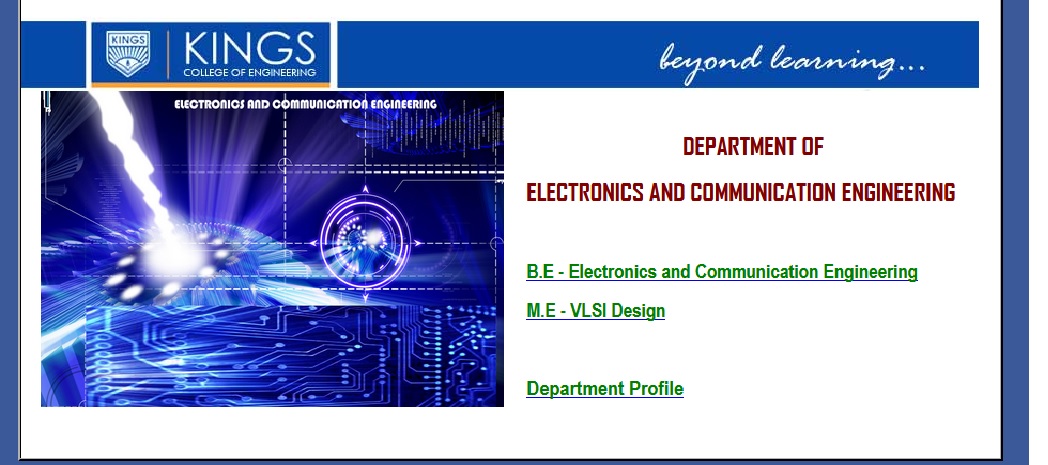EE1152 Electric Circuits & Electron Devices B.E Question Bank : kings.ac.in
Name of the College : Kings College of Engineering
University : Anna University Chennai
Department : Electronics and Communication Engineering
Subject Code/Name : EE1152 Electric Circuits & Electron Devices
Year : I
Semester : II
Degree : B.E
Website : kings.ac.in
Document Type : Question Bank
Download :https://www.pdfquestion.in/uploads/ki…556-EE1152.pdf
Kings Electric Circuits & Electron Devices Question Paper
Unit – I
Circuit Analysis Techniques
Part – A (2 Marks) :
1. Explain star and delta connection of impedances.
2. State Superposition theorem.
3. State Thevenin’s theorem.
4. State Norton’s theorem.
Related : Kings College of Engineering CE1354 Design of Steel Structure B.E Question Bank : www.pdfquestion.in/1552.html
5. State Maximum Power transfer theorem
6. State and explain KCL.
7. State and explain KVL.
8. Explain duality.
9. Determine the Missing Voltage across the elements in the circuit
10. Find total Inductance

Part – B (16 Marks) :
1. Apply KCL and KVL to the circuit shown in fig.
2. Find the current through branch AB by using superposition theorem.
3. Find the current through 5 ohm resistance using Superposition theorem.
4. Find the current through 10 ohm resistance using Nortan’s theorem.
5. Find the Current (I) in 20 Resistance using Thevenin’s theorem
6. Find the resistance between A & B , A & C
7. Consider the following network as shown in figure. Determine the power observed by the 6 .
8. Find the total Current and total Resistance in the circuit given
Unit – II
Transisent Response And Resonance In RLC Circuits :
Part – A (2 Marks) :
1. What is significance of initial conditions?
2. Write a note on initial conditions in basic circuit elements.
3. What is time constant?
4. Write a note on under damped, over damped and critically damped systems.
5. Define (i) rise time, (ii) time delay in respect of step response of second order system.
6. What do you mean by resonance?
7. What is Q-factor?
8. What is anti-resonance?
9. Find the value of Q-factor for an Inductor & Capacitor.
Part – B (16 Marks) :
1. Derive an expression for step response of series R-L circuit.
2. Derive an expression for step response of series R-C circuit.
3. Explain about current decay in source free series R-L circuit.
4. In how many seconds after t=o has the current i(t) become one half of its initial value in the given circuit shown in fig.
5. Explain the step response of RLC circuit.
6. Find the expression for the current in a series RLC circuit fed by a D.C. voltage of 20v with R=8W, L=5H, C=1/8F. Assume the initial conditions to be zero.
7. Explain Series Resonance.
8. A series RLC circuit consists of R=50W, L=0.05H and C=0.05µF. Calculate the frequency of resonance. A variable frequency sinusoidal voltage of value 50v is applied to the circuit. Find the frequency at which voltage across L & C is maximum. Also calculate voltages across L & C at frequency of resonance. Find maximum current in the circuit.
9. Briefly explain the parallel resonance.
10. A resistor & capacitor are in series with a variable inductor. When the circuit is connected to 200v, 50Hz supply, the maximum current obtained by varying the inductance is 0.314A. the voltage across capacitor, when the current in the circuit is maximum is 800v. find the values of series circuit elements.
Unit – III
Semiconductor Diodes :
Part – A (2 Marks) :
1. What is charged particle? Define the unit of the charge.
2. What are the applications of CRO?
3. What is valance band?
4. What is covalent band?
5. What is forbidden band?
6. Explain semiconductor types?
7. Define energy level and energy band.
8. What is Fermi level?
9. What is a semiconductor?
10. What is meant by electron –hole pair?
11. What is p-type semiconductor?
12. What is doping?
13. What is hole current /electron current?
14. Define law of mass of action
15. What is drift current?
16. What is diffusion current?
17. What is forward and reverse resistance of a diode?
18. What is cut in voltage of a diode?
19. What is switching characteristics of diode?
20. What is Zener break down voltage?
21. Give the expression for transition capacitance of a diode (CT ).
22. What are applications for zener diode?
Part – B (16 Marks) :
1. Explain the theory of PN junction and explain how it acts as diode?
2. Derive the diode equation of the diode
3. Explain and derive the current components and switching characteristics of diode?
4. Derive the expression for transition and diffusing capacitance.
5. Explain the Zener diode and it’s breakdown mechanism?